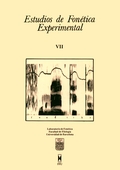En torno a las vocales del español: análisis y reconocmiento
Abstract
In this study we intended to carry out an analysis of male and femaIe vowel formants to obtain the data that would serve us to draw the boundaries between the different vowel categories, and could also be used for automatic recognition of vowels through association of any data outside the boundaries established by phonetic features. We have succeeded in proving that the first two vowel formants sufficed to characterize any of the five Spanish vowels, that F1 serves to distinguish between the features: high, middle and low, and also that F2 plays an important role in the identification of front, central and back vowels. We have aIso obtained two formuli that relate in a systematic way male vowel formants to female vowel formants. We have found the limits necessary (or the rules to work, and, finally we created a speech recognition programme and verified that 90% of the vowels of various words uttered by different speakers, were accurately recognised.
Downloads
Published
How to Cite
Issue
Section
License

This work is licensed under a Creative Commons Attribution-NonCommercial-NoDerivatives 4.0 International License.
All articles published online by Estudios de Fonética Experimental are licensed under Creative Commons Attribution-NonCommercial-NoDerivs 4.0 International (CC BY-NC-ND 4.0 DEED), unless otherwise noted. Estudios de Fonética Experimental is an open access journal. Estudios de Fonética Experimental is hosted by RCUB (Revistes Científiques de la Universitat de Barcelona), powered by Open Journal Systems (OJS) software. The copyright is not transferred to the journal: authors hold the copyright and publishing rights without restrictions. The author is free to use and distribute pre and post-prints versions of his/her article. However, preprint versions are regarded as a work-in-progress version used as internal communication with the authors, and we prefer to share postprint versions.




